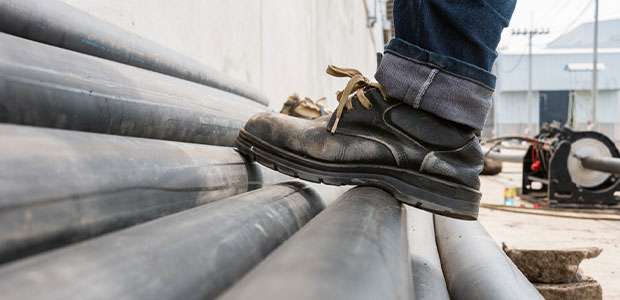
Safety Shoes Make the Outfit for Well-Protected Workers
When you are wearing safety shoes, you are more likely to be protected from common hazards.
- By Emily Milford
- Oct 01, 2021
Do you remember the first time you were required to wear safety or steel toe shoes? You likely complied by purchasing a pair without really thinking about how and why they would protect you. Before the term personal protective equipment (PPE) came to be, workers during the industrial revolution were already inventing ways to protect themselves. French and British farmers wore sabots, hallowed out wooden shoes to protect their feet. These shoes protected them from falling objects and famously became known because workers threw their sabots into production machinery during protests. This is how the word sabotage came into existence.
True safety shoes appeared in the 1940s when German soldiers in WWII were issued boots with reinforced metal toecaps. After this time, safety shoes became prevalent with workers in many countries. Then in 1970, the U.S. established the Occupational Safety and Health Act, which gave the Federal government the authority to set and enforce health and safety standards for American workers.
OSHA Requirements Today
OSHA outlines foot protection requirements in standard 29 CFR 1910.132 and 1910.136. The general requirements state that “The employer shall ensure that each affected employee uses protective footwear when working in areas where there is a danger of foot injuries due to falling or rolling objects, or objects piercing the sole, or when the use of protective footwear will protect the affected employee from an electrical hazard, such as a static-discharge or electric-shock hazard, that remains after the employer takes other necessary protective measures.”
OSHA suggests protective footwear be worn in situations involving the following dangers:
- corrosive or poisonous materials
- electrical hazards
- static electricity that could cause an explosion
- heavy objects that could roll onto feet
- sharp objects that could puncture the foot
- molten metal that could splash onto feet
- hot or slippery surfaces
Why and How They Protect You
There are many occupational hazards for feet. In fact, according to the Bureau of Labor Statistics, there are more than 53,000-foot injuries per year leading to missed work days. This means that on average, 4.8 individuals per 10,000 full-time workers are missing work due to foot injuries. While foot injuries affect workers of all ages, the Bureau of Labor Statistics says injuries to the foot most frequently occur in workers in the 16-19 age range.
This article originally appeared in the October 2021 issue of Occupational Health & Safety.